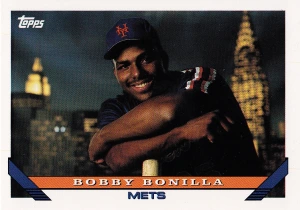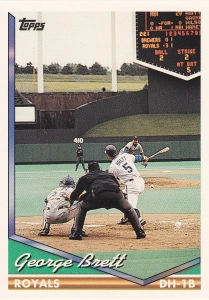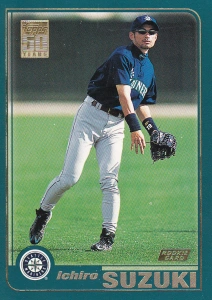The next set I’ll look at with ties to 2011 Topps Lineage is from the 1960’s – starting in 1959 actually – Topps Venezuelan. Topps authorized printing of a Venezuelan version of some series of the base set during certain years. Below is some info on each year. Again, I have to direct folks to The Topps Archives blog for where I got a little bit more detailed information than the Standard Catalog has.
1959 Topps Venezuelan
As the professional baseball league in Venezuela became popular – Topps attempted to capitalize on this market through a partnership with a Venezuelan company called Benco. They printed the same first two series of Topps cards – up through card #198. Some of the cards have copyright on the back that Benco printed the card, but some have the same Topps copyright. For either version, the biggest difference is the lack of gloss on the front.
Hall of famers (14): Ford Frick, Mickey Mantle, Duke Snider, Nellie Fox, Warren Spahn, Willie Mays, Jim Bunning, Stan Musial, Enos Slaughter, Sandy Koufax, Yogi Berra, Al Kaline (subset only), Ernie Banks (subset), Robin Roberts (subset)
1960 Topps Venezuelan
Topps came back the next year and again produced parallels of the first and second series (#’s 1-198). These cards have no typing differences between the regular and Venezuelan cards; the only way to tell the Venezuelan cards is that they have less gloss and the colors are not as bright. This set is notable in that it includes the rookie card of Carl Yastrzemski (#148).
Hall of famers (14): Early Wynn, Ernie Banks, Brooks Robinson, Sparky Anderson, Whitey Ford, Al Kaline, Bill Mazeroski, Bob Gibson, Whitey Herzog, Nellie Fox, Yaz RC, Willie Mays (subset only), Hoyt Wilhelm (subset), Mickey Mantle (subset)
Ford C. Frick award winner Tony Kubek also has a card in this set.
1962 Topps Venezuelan

Topps began a trend of skipping a year, so the next set is the 1962 Venezuelan set. These were the first cards where the backs were written in Spanish – except for the statistics. The first two series are again reproduced, except the last 2 cards (#197 & 198) were replaced by Elio Chacon and Luis Aparicio as cards #199 & 200, both of whom were born in Venezuela. The first 2 series had a number of subsets, including the Babe Ruth story, so this one has a ton of HOF-ers. Roger Maris is card #1 in tribute to his breaking the Babe’s HR record. I wrote about this set in one of my Heritage posts.

Hall of famers (22): Sandy Koufax, Roberto Clemente, Ernie Banks, Casey Stengel (MG), Eddie Mathews, Orlando Cepeda, Brooks Robinson, Stan Musial, Harmon Killebrew, Nellie Fox, Warren Spahn, Al Kaline, Aparicio, Babe Ruth (subset only), Lou Gehrig (subset), Miller Huggins (subset), Willie Mays (subset) Mickey Mantle (subset), Frank Robinson (subset), Jim Bunning (subset), Whitey Ford (subset), Don Drysdale (subset)
1964 Topps Venezuelan

Topps again skipped a year, but when they came back to the South American market that had increased to including the first 4 series – netting a total of 370 cards. However, this time, the cards have English writing on the back. As with previous years, the cardstock for the Venezuelan cards is not as good, and there is no gloss whatsoever on the front. Most distinguishing, however, is that there is black border on the back, whereas the regular Topps set had an orange border.

Hall of famers (30): Hoyt Wilhelm, Yogi Berra, Lou Brock, Eddie Mathews, Mickey Mantle, Ernie Banks, Walter Alston MG, Don Drysdale, Willie Mays, Duke Snider, Billy Williams, Harmon Killebrew, Sandy Koufax, Nellie Fox, Carl Yastrzemski, Brooks Robinson, Al Lopez, Al Kaline, Frank Robinson, Jim Bunning, Juan Marichal, Robin Roberts, Hank Aaron, Casey Stengel, Willie Stargell, Willie McCovey, Warren Spahn (subset only), Whitey Ford (subset), Roberto Clemente (subset), Orlando Cepeda (subset)
1966 Topps Venezuelan
Continuing with even-numbered years only, the next Topps Venezuelan set was 1966. This was another 370-card set matching the first 4 series. The backs are the only distinguishing feature – they are noticeably darker.
Hall of famers (29): Willie Mays, Phil Niekro, Jim Hunter, Billy Herman MG, Mickey Mantle, Carl Yastrzemski, Tony Perez, Red Schoendienst, Sandy Koufax, Ernie Banks, Walter Alston MG, Harmon Killebrew, Lou Brock, Jim Palmer, Orlando Cepeda, Whitey Ford, Joe Morgan, Eddie Mathews, Bill Mazeroski, Willie Stargell, Don Sutton, Roberto Clemente, Frank Robinson, Bob Gibson, Hank Aaron (subset only), Willie McCovey (subset), Billy Williams (subset), Juan Marichal (subset), Don Drysdale (subset)
Ford C. Frick award winner Bob Uecker also has a card in this set.
1968 Topps Venezuelan
Topps again skipped a year before releasing its final Venezuelan parallel in 1968. Again a 370-card set, the cards are identical replicas except for the noticeably cheaper cardboard and the notation of being printed in Venezuela. This set has 3 pretty notable cards all included in the Venezuelan version – the Jerry Koosman rookie which also featured the future GM of the Rangers, Johnny Bench’s RC and Mickey Mantle’s last Topps card.
Hall of famers (35): Brooks Robinson, Billy Williams, Tom Seaver, Willie Mays, Eddie Mathews, Rod Carew, Gaylord Perry, Willie Stargell, Dick Williams MG, Bob Gibson, Don Sutton, Hank Aaron, Tony Perez, Joe Morgan, Don Drysdale, Roberto Clemente, Nolan Ryan RC, Orlando Cepeda, Juan Marichal, Jim Bunning, Harmon Killebrew, Al Kaline, Johnny Bench RC, Carl Yastrzemski, Phil Niekro, Mickey Mantle, Willie McCovey, Red Schoendienst MG, Luis Aparicio, Leo Durocher MG, Hoyt Wilhelm, Ernie Banks, Lou Brock (subset only), Frank Robinson (subset), Fergie Jenkins (subset)




























